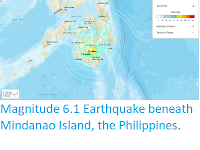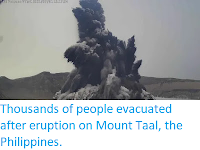About 1100 people have been evacuated from five communities around Lake Taal on Luzon Island, the Philippines, following an eruption on Mount Taal, an 311 m high volcano forming an island in the middle of the lake on Saturday 26 March 2022. Activity on the volcano began slightly after 7.20 am local time, with a series of phreatic explosions (explosions caused by hot magma or lava coming into contact with water), which produced a column of ash and steam about 1.5 km high, as well as a rain of hot mud and strong smell of sulphur dioxide which affected local communities. The Philippine Institute of Volcanology and Seismologyhas raised the alert level of the volcano following the eruption, and begun evacuations of communities around Lake Taal.
While the volcano is in itself dangerous, much of the concern is that Earthquakes or eruptions around it could trigger a landslide into the lake, triggering a tsunami wave. Tsunamis occur when large volumes of water are displaced by geological events, such as landslips or Earthquakes, forming waves which spread out through the surrounding water. Like other waves, tsunamis are not necessarily obvious in deep, open waters, but when they reach shallow or enclosed waterways can be extremely dangerous. This is because a tsunami isn't just a wave above the normal water-level, it is pressure wave beneath the surface, which is amplified in the enclosed space. A tsunami reaching the shore is typically preceded and followed by rapidly shallowing water. Thus people in areas prone to tsunamis know to evacuate the coast rapidly if the tide apparently goes out rapidly, since this is likely to be followed by the tide coming in rapidly. This gives us the English term 'tidal wave' which is no longer used, since it is inaccurate; the tides are caused by the gravity of the sun and moon, tsunamis are nothing to do with the tide. The term 'tsunami' comes from Japan, where earthquakes, and therefore tsunamis, are common.
The geology of the Philippines is complex, with the majority of the islands located on the east of the Sunda Plate. To the east of this lies the Philippine Sea plate, which is being subducted beneath the Sunda Plate (a breakaway part of the Eurasian Plate); further east, in the Mariana Islands, the Pacific Plate is being subducted beneath the Philippine Sea Plate. This is not a smooth process, and the rocks of the tectonic plates frequently stick together before eventually being broken apart by the rising pressure, leading to Earthquakes in the process. Material from the subducting Philippine Plate is heated by the temperature of the Earth's interior, causing lighter minerals to melt and the resultant magma to rise through the overlying Sunda Plate, fuelling the volcanoes of the Philippines.
See also...



Follow Sciency Thoughts on Facebook.
Follow Sciency Thoughts on Twitter.






